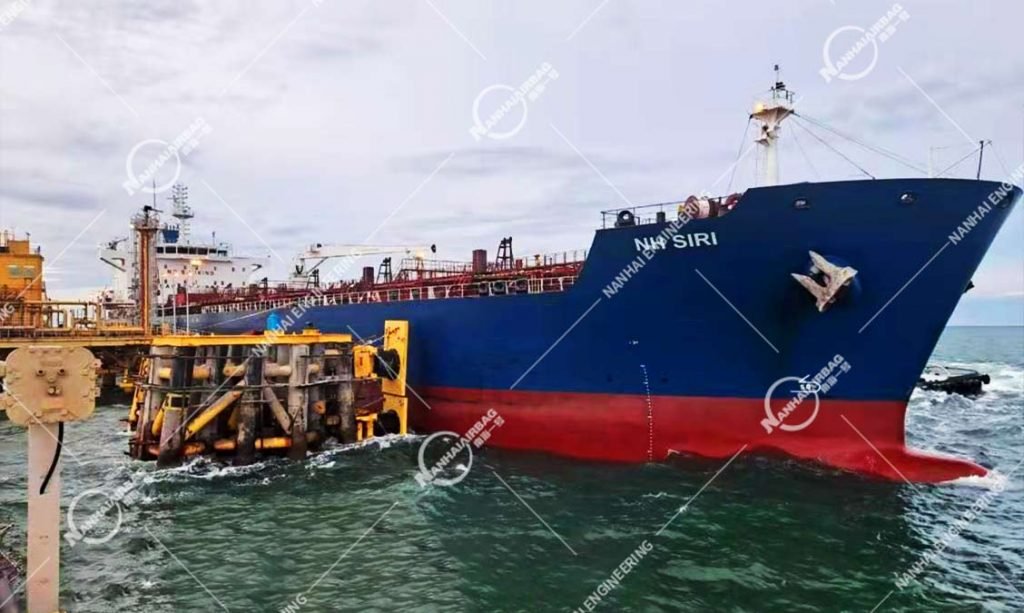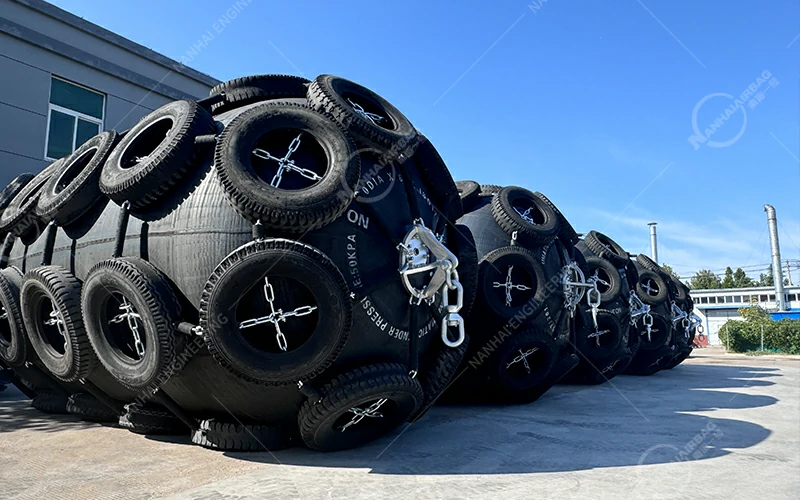Upgraded version of ship launching airbags: Beenest airbags
05/15/2025Advantages of Using Pneumatic Fenders in Shipping
05/16/2025Maintenance Tips for Marine Fenders
Marine fenders play a crucial role in maritime safety. They help cushion impacts and protect vessels and docking structures from damage.
However, their effectiveness depends on proper maintenance. Keeping up with regular inspections, cleaning, and repairs can really help extend their lifespan and make sure they perform at their best.
This article provides practical tips for maintaining marine fenders. It encompasses everything from regular inspections to sophisticated maintenance strategies.
If you’re a boat owner, marina operator, or work in the maritime industry, these tips will help you maintain your fenders in great condition.

Understanding Marine Fenders
Marine fenders are essential for protecting vessels and docks. They act as a buffer, absorbing the energy from collisions.
There are several factors that can affect their performance, such as size and type. Each type is tailored for specific environments and conditions.
Regular maintenance of these fenders is vital. It makes sure that everything keeps working as it should.
Environmental elements like UV rays and shifts in temperature can impact how long fenders last. Taking proper care can really help reduce these effects.
A solid maintenance routine includes regular inspections and cleaning. These steps are designed to catch any issues early on, before they escalate into serious problems.
To wrap it up, knowing about different fender types and their maintenance requirements is key to keeping things safe and budget-friendly.
Types of Marine Fenders
There are several types of marine fenders available, each with unique features.
Pneumatic fenders are known for their flexibility and durability. They’re often used in large vessels and on docks.

Foam-filled fenders are suitable for areas prone to high impact. They require minimal maintenance. Rubber fenders are durable and cost-effective, ideal for many applications.

Cone fenders have a high energy absorption capacity, making them suitable for heavy-duty docking. Each type caters to various docking requirements, providing unique advantages depending on the circumstances.

The Role of Marine Fenders in Docking Safety
Fenders are a critical part of docking safety. They reduce the risk of damage to both vessels and docks.
When ships come into dock, fenders play a crucial role by absorbing the kinetic energy, which helps to prevent any direct impact. This reduces potential repairs and operational downtime.
A well-maintained fender ensures a smooth docking process. It reduces noise and creates a safer atmosphere for passengers.
In conclusion, fenders are more than protective gear. They play a crucial role in ensuring that operations run smoothly and safely.
Regular Inspection and Cleaning
Regular inspections and cleaning are crucial for marine fender longevity. A consistent schedule helps catch problems early. This can save time and money in the long run.
First, inspect your fenders visually for obvious signs of damage. Look for cuts, abrasions, and deformations. Such issues compromise fender integrity.
Next, check the fender pressure if using pneumatic fenders. Making sure the pressure is just right is key to getting the best performance and keeping things safe. Low pressure can lead to inadequate protection.
Cleaning is also key. Accumulated dirt and marine growth can degrade the fender surface. This can reduce effectiveness over time.
Finally, keep a checklist handy for each inspection. This helps keep track of maintenance tasks. Make sure to check the overall condition and pressure levels.
Visual Inspection for Damage
Begin with a thorough visual check. Look closely for any signs of wear or damage. Inspect the surface for cuts and cracks.
Deformations can also indicate potential problems. Any changes in shape can affect performance. Check for material breakdown, which weakens the fender over time.
Ensure that all fender accessories are intact. Chains, for example, should be rust-free. Avoiding corrosion ensures long-term use and reliability.
Cleaning Procedures for Marine Fenders
Cleaning fenders is vital to their upkeep. Use mild detergents and soft brushes. These tools help protect surfaces from damage while you’re cleaning.
Make sure to scrub regularly to get rid of any marine growth and pollutants. This protects the fender from degradation. Steer clear of harsh chemicals that can wear down materials.
Lastly, rinse fenders thoroughly with fresh water. This removes residue and maintains surface quality. Implementing these steps guarantees not just performance but also lasting appeal.
Repair and Maintenance Techniques
Consistent maintenance extends the life of your marine fenders. Addressing wear and tear promptly is crucial. Keeping an eye on things can stop small issues from turning into big headaches.
A crucial part of maintenance is figuring out when it’s time to repair or replace fenders. You can often fix minor damages using some straightforward techniques. If there’s significant damage, it may be necessary to replace it to guarantee safety.
Prioritize repair in the maintenance process. Ignoring small issues can lead to high costs later. A well-maintained fender functions efficiently, offering better protection.
Repairs depend on the severity of the damage. Small punctures or tears are usually patchable. Use manufacturer-approved repair kits for the best results.
In summary, follow a structured repair routine for longevity. Record all maintenance activities. This is great for keeping track of how well things are working and for spotting any potential issues before they arise.
Addressing Wear and Tear
Wear and tear are inevitable for marine fenders. Environmental factors can really accelerate this process. Look for early signs and act swiftly.
Check for cracks and deformations regularly. These suggest that the materials are losing strength. Addressing them early ensures continued protection.
Monitor the fender’s surface for signs of abrasion. Abrasions can lead to significant damage if left unattended. Taking protective measures and making timely repairs can really help reduce risks effectively.
In some cases, simple cleaning can address minor wear. Removing debris enhances the fender’s lifespan. Routine actions like these go a long way in maintaining quality.
Repairing Damaged Fenders
Timely repairs are essential to maintaining fender functionality. For minor punctures or tears, patching is often effective. A proper repair kit is crucial for success.
Identify repair needs promptly. This avoids escalating issues. Proper assessments help us figure out the best way to move forward.
Consult manufacturer’s guidelines when repairing. Using approved materials is key to making sure repairs last. Steer clear of makeshift solutions, which often fail under pressure.
Remember, quality repairs restore fender integrity. This minimizes risks and ensures safe docking experiences. Reliable repairs also help avoid costly replacements.
Storage and Installation Best Practices
Proper storage and installation are vital for the longevity of marine fenders. These practices are essential for keeping your fender in top shape and ensuring it works well over time. Storing fenders correctly prevents unnecessary wear and environmental damage.
Make sure your fenders are installed according to the manufacturer’s guidelines. Misalignment often leads to reduced efficiency and performance. Making small tweaks during installation can really boost your protection.
Here are some best practices for both storage and installation:
- Store fenders in a dry, cool place away from direct sunlight.
- Use racks or shelves to prevent pressure spots.
- Install dock fenders at appropriate heights for maximum vessel protection.
- Adjust fender positions based on vessel size and dock height.
Embracing these practices not only enhances safety but also boosts cost efficiency, ensuring you get the most out of your investment.
Proper Fender Storage
Taking good care of marine fenders can really make them last a lot longer. Always store in a shaded area to avoid UV damage. Ensure the storage environment is dry to prevent mildew or mold.
Use storage methods that distribute weight evenly. Hanging fenders vertically can minimize deformities. This method is great for keeping their shape and effectiveness intact.
Correct Installation for Optimal Performance
Installation quality directly impacts fender performance. Make sure to stick to the manufacturer’s guidelines for a flawless installation. Misplaced fenders may lead to improper impact absorption.
Position fenders according to the docking environment. Keep in mind that adjustments might be necessary depending on the water levels. Getting the positioning just right is key to keeping your vessel safe in any situation.
Advanced Maintenance Strategies
To keep your marine fenders in top shape, think about adopting some cutting-edge maintenance strategies. These methods blend expert insights with the use of technology. Using these strategies can really boost the longevity and effectiveness of your fenders.
Using advanced methods brings a host of benefits. It’s great for spotting problems early on and fine-tuning maintenance schedules. This forward-thinking approach works to reduce the likelihood of sudden fender failures.
Here are some advanced strategies to consider:
- Schedule regular professional inspections to identify hidden issues.
- Utilize real-time monitoring systems to keep track of fender conditions.
- Implement a detailed documentation process for maintenance activities.
- Set up a fender management system for efficient oversight.
- Use data analytics to predict maintenance needs and extend fender life.
These strategies work together to create a thorough approach to maintaining your fender, enhancing both its reliability and safety.
Professional Inspections and Real-Time Monitoring
Professional inspections play a vital role in revealing hidden fender problems. Experts can provide insights that might be missed during routine checks. Regular inspections are key to keeping your fenders in top shape and working effectively.
Real-time monitoring systems provide ongoing supervision. They provide instant alerts if a fender’s condition changes. This technology enables quicker response times to potential problems.
Combining human expertise with technology ensures fenders are always in peak condition. This two-pronged strategy boosts both safety and functionality.
Fender Management Systems and Documentation
Looking to make your maintenance operations smoother? Fender management systems are here to help streamline everything! They help create a well-structured schedule and make sure resources are used efficiently. Having a system in place helps manage multiple fenders across different sites.
Documentation plays a crucial role in any maintenance strategy. Keeping track of inspections and repairs helps us spot trends over time. This data is incredibly useful for planning and budget forecasting.
A solid documentation process is key to staying compliant with safety regulations. It also boosts accountability and keeps a record of maintenance history for any audits that might be needed.
Conclusion: The Importance of Fender Maintenance
Proper maintenance of marine fenders is vital for maritime safety. Keeping up with regular inspections and making timely repairs can save you from expensive damages down the line. They also help to prolong the life of the fenders, making sure they perform reliably.
By following these maintenance tips, you safeguard both vessels and docking structures. Taking consistent care is essential for effective docking protection, giving all maritime operators peace of mind.
